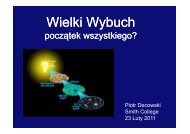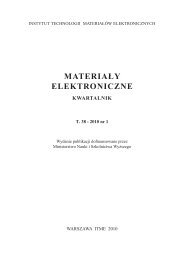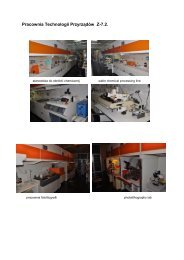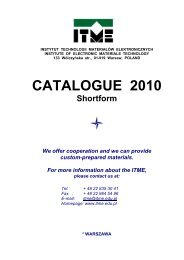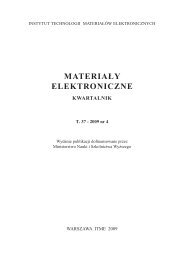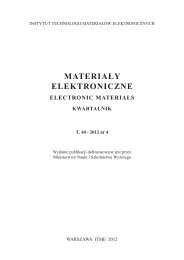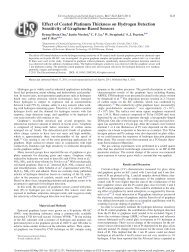MATERIAÅY ELEKTRONICZNE - ITME
MATERIAÅY ELEKTRONICZNE - ITME
MATERIAÅY ELEKTRONICZNE - ITME
You also want an ePaper? Increase the reach of your titles
YUMPU automatically turns print PDFs into web optimized ePapers that Google loves.
P. Kamiński, M. Kozubal, J.D. Caldwell, ...<br />
that the proportions of the TI3-trap concentration<br />
to the TI4-trap concentration in the both epilayers<br />
are very similar being close to 0.7 with an error<br />
less than 10%. Furthermore, the activation energies<br />
of these traps match up very well with the energy<br />
levels E v<br />
+ (1.65–2.21) eV and E v<br />
+ (1.90–2.09) eV<br />
that are calculated by DFT for V C<br />
(2-/-) and V C<br />
(-/0),<br />
respectively [25]. Experimental results obtained from<br />
photo-EPR measurements also indicate that the level<br />
corresponding to V C<br />
(-/0) is located at ~E c<br />
– 1.1 eV<br />
[26]. Thus, the traps TI3 and TI4 are likely to be<br />
attributed to the two acceptor states of the carbon<br />
vacancy.<br />
The parameters of trap TI5 indicate that this may<br />
be the same trap as the EH 6<br />
center that was detected<br />
by Danno and Kimoto in epitaxial 4H-SiC by deconvolution<br />
the broad DLTS peak corresponding to the<br />
known EH 6/7<br />
center [19]. The significant concentration<br />
of the EH 6<br />
center, equal to 1.3×10 13 cm -3 , was<br />
observed after the electron irradiation at an energy of<br />
116 keV with a dose of 3 × 10 17 cm -3 and annealing at<br />
950 o C for 30 min. In view of recent results obtained<br />
by low-temperature photoluminescence microspectroscopy<br />
of electron-irradiated epitaxial 4H-SiC,<br />
combined with calculations of local vibration mode<br />
energies of C interstitial clusters [27], the trap TI5<br />
seems to be related to the dicarbon interstitial. It<br />
has been shown that C interstitials are extremely<br />
mobile and under the conditions associated with<br />
electron irradiation, interstitial carbon aggregates are<br />
formed [27]. The formation of dicarbon interstitials<br />
supports the fact that in the epilayer A, which had<br />
a lower N concentration, the concentration of trap<br />
TI5 (Fig. 5) is approximately two times lower than<br />
the concentrations of traps TI3 and TI4 which are<br />
assigned to carbon vacancies. In the epilayer B, the<br />
concentration of trap TI2 represents approximately<br />
a half of the concentrations of traps TI3 and TI4,<br />
for the vast majority of the dicarbon interstitials<br />
are captured by nitrogen atoms. Therefore, the concentration<br />
of the irradiation induced TI5 centers,<br />
equal to 1.25 × 10 12 cm -3 , is very low compared to<br />
the concentrations of the other traps detected in the<br />
epilayer B after the irradiation.<br />
IV.<br />
CONCLUSIONS<br />
The low-energy electron irradiation has been used<br />
as a tool for identification of electron traps in epitaxial<br />
4H-SiC observed by the DLTS technique. The<br />
effect of the nitrogen content on the properties and<br />
concentrations of the deep-level defects is shown. On<br />
the grounds of our experimental results, as well as by<br />
taking into account the earlier reported dependences<br />
of the Z 1/2<br />
center concentration on the C/Si ratio, we<br />
have tentatively attributed the center to the divacancy<br />
V C<br />
V Si<br />
formed by the nearest neighbor silicon and<br />
carbon vacancies located in different (h or k) lattice<br />
sites. It is shown that the minority carrier lifetime in<br />
n-type epitaxial 4H-SiC is predominantly affected by<br />
the Z 1/2<br />
center concentration. In particular, we demonstrate<br />
that when the Z 1/2<br />
center concentration goes up<br />
from 1.8×10 12 to 3.4 × 10 12 cm -3 the carrier lifetime<br />
decreases from 970 to 520 ns. This result completes<br />
the experimental data presented in Refs. 11 and 12<br />
showing the decrease in the lifetime for the Z 1/2<br />
center<br />
concentrations higher than 10 13 cm –3 . The capture<br />
cross-section of the Z 1/2<br />
center for holes is found to<br />
be ~ 6.0 × 10 -14 cm 2 . The substantial increase in the<br />
Z 1/2<br />
center concentration induced by the low-energy<br />
electron irradiation is observed. The concentration<br />
of this center seems to be dependent either on the<br />
residual concentration of silicon vacancies in the<br />
as-grown material, or on the nitrogen concentration.<br />
Four irradiation-induced deep electron traps with the<br />
activation energies of 0.71, 0.78, 1.04 and 1.33 eV<br />
have been revealed. The 0.71-eV trap, observed only<br />
in the epilayer with a higher nitrogen concentration,<br />
is tentatively identified with the complex defect arising<br />
from the capture of a dicarbon interstitial by a<br />
nitrogen atom. The 0.78-eV and 1.04-eV traps are<br />
assigned to the carbon vacancy levels for V C<br />
(2-/-)<br />
and V C<br />
(-/0), respectively, whereas the 1.33-eV trap is<br />
proposed to be related to the dicarbon interstitial.<br />
ACKNOWLEDGMENTS<br />
This work was partly supported by the Polish Ministry<br />
of Science and Higher Education through grant<br />
No. 0421/B/T02/2009/37.<br />
REFERENCES<br />
[1] Klein P. B.: Identification and carrier dynamics of<br />
the dominant lifetime limiting defect in n- 4H-SiC<br />
epitaxial layers, Phys. Status Solidi A, 206, (2009),<br />
2257<br />
[2] Giles A. J., Caldwell J. D., Stahlbush R. E., Hull B.<br />
A., Mahadik N. A., Glembocki O. J., Hobart K. D.,<br />
Liu K. X.: Electroluminescence spectral imaging of<br />
extended defects in 4H-SiC, J. Electron. Mater., 39,<br />
(2010), 777<br />
[3] Troxell J. R., Chatterjee A. P., Watkins G. D., Kimerling<br />
L. C.: Recombination-enhanced migration<br />
33




